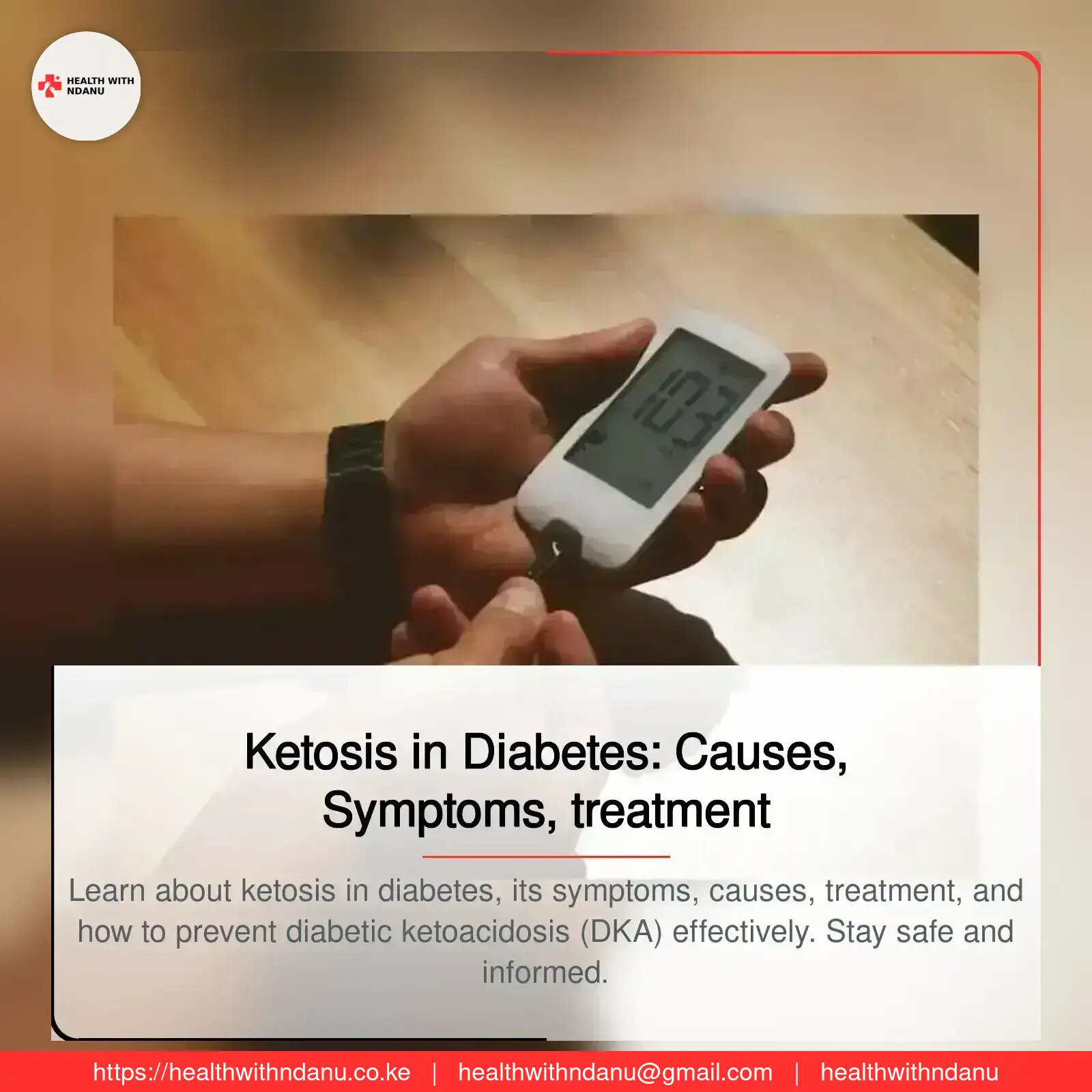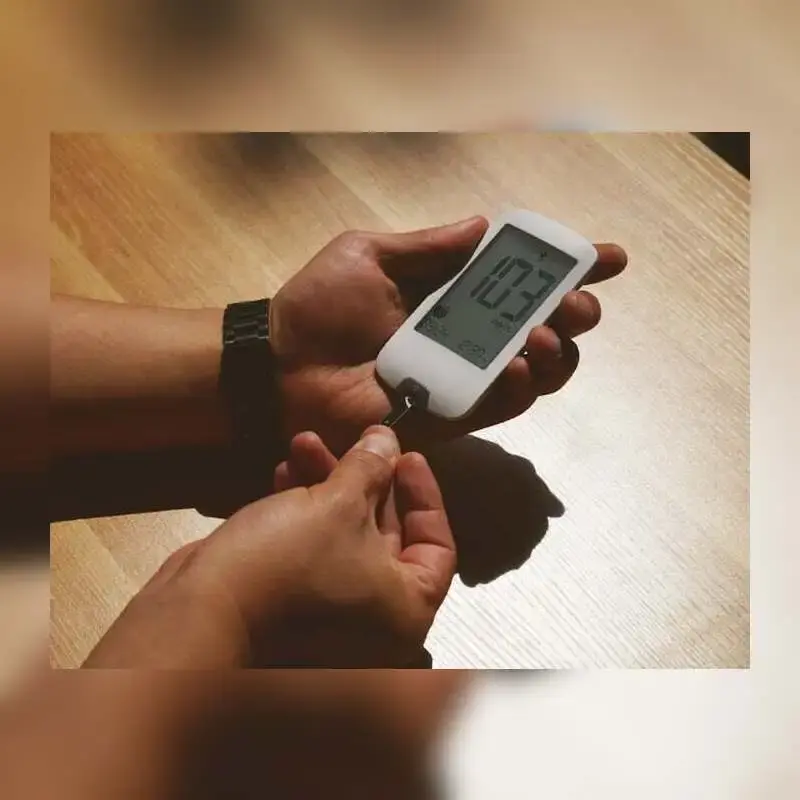Ketosis in Diabetes: Causes, Symptoms, treatment
- by Diana Ndanu
- 22 March, 2025
- 0 Comments
- 4 Mins



Introduction
In many communities, diabetes is becoming more common, and with it comes a dangerous complication called ketosis. Yet, few people fully understand what ketosis means, how it relates to diabetes, or how it can be prevented and managed.
This article aims to educate and create awareness about ketosis in diabetes, especially for those living with diabetes or caring for someone who does. We also share a message of hope and encouragement for anyone struggling with this condition.
What is Ketosis in Diabetes?
Ketosis is a condition where the body starts breaking down fats for energy, producing substances called ketones. This process happens when the body lacks enough insulin to use glucose (sugar) properly for energy.
While ketosis can occur normally in healthy people during fasting or following a low-carb diet, it becomes dangerous in people with diabetes, especially when insulin is too low. In such cases, ketosis can develop into diabetic ketoacidosis (DKA), a serious and life-threatening emergency where high ketone levels make the blood too acidic.
What Causes Ketosis in Diabetes?
For people living with type 1 diabetes and sometimes type 2 diabetes, several factors can cause ketosis:
1. Skipping insulin doses or not taking enough insulin
2. Infections (e.g., pneumonia, urinary tract infections
3. Stress or illness, which increases insulin demand
4. Dehydration, which concentrates ketones in the blood
5. Poor diabetes management, such as frequent high blood sugar levels
6. Unsupervised low-carb dieting, which can trigger unsafe Ketosis
When the body cannot use glucose for energy, it starts breaking down fats, producing ketones, which in excess, can overwhelm the body’s balance.
Signs and Symptoms of Ketosis and Diabetic Ketoacidosis (DKA)
It is important to recognize the signs early. Common symptoms include:
- Extreme thirst and dry mouth
- Frequent urination
- Nausea and vomiting
- Abdominal pain
- Fruity or sweet-smelling breath
- Deep, rapid breathing
- Weakness or fatigue
- Confusion or difficulty focusing
In severe cases, loss of consciousness
Treatment of Ketosis in Diabetes
Mild ketosis can sometimes be managed at home under the guidance of a healthcare provider, but DKA always requires urgent medical care.
For Mild Ketosis:
- Drink water or oral rehydration solutions to flush out ketones.
- Monitor blood glucose and ketone levels regularly.
- Take insulin as prescribed to reduce blood sugar and stop ketone production.
- Seek advice from a health worker immediately if unsure.
For Diabetic Ketoacidosis (DKA):
- Go to the nearest hospital immediately.
- Treatment includes IV fluids, electrolyte replacement, and insulin drip.
- Medical professionals will also treat underlying causes such as infections.
Managing Ketosis in Diabetes
1. Consistent Insulin Use
- Take insulin as prescribed.
- Never skip insulin doses, even when sick.
2. Monitor Regularly
- Check blood glucose several times daily.
- Use urine or blood ketone strips to monitor ketone levels, especially during illness or when blood sugar is high.
3. Hydration
- Drink plenty of water to help remove ketones from the body.
4. Have a Sick-Day Plan
- Work with a healthcare provider to create a plan for managing diabetes during illness.
5. Balanced Nutrition
- Eat regular, balanced meals.
- Avoid making drastic dietary changes (e.g., low-carb diets) without professional guidance.
6. Regular Medical Reviews
- Attend all diabetes clinic appointments.
- Get educated about diabetes and ketosis through community health programs.
Encouragement to Anyone Struggling with Ketosis or DKA
- To anyone battling diabetes and facing the fear of ketosis or diabetic ketoacidosis, you are not alone.
- Managing diabetes can feel overwhelming, especially when complications like ketosis arise. But remember, this condition is manageable with the right steps and support.
- Stay connected with your healthcare provider.
- Involve family and friends in your care—they can help remind you to check blood sugar, prepare healthy meals, or even just offer emotional support.
- Be kind to yourself—diabetes is a daily challenge, but every step you take towards proper management counts.
- Never ignore warning signs, and always act early.
- With proper care, education, and community awareness, many people living with diabetes can prevent and successfully manage ketosis, avoiding dangerous situations like DKA.
- Your health matters, and so does your life. Don’t hesitate to seek help and encourage others to learn about diabetes care too.
Conclusion
Ketosis in diabetes is a serious condition, but with knowledge and preparation, it can be managed and prevented. Communities should continue raising awareness, supporting one another, and advocating for better access to diabetes care and education.
Let us stand together and say “No more silent suffering!” Spread the word, support those in need, and let’s build healthier communities.
Got Your Own Experience? Share with us
Popular Categories
Mablogu Zinazobambwa Sana
Daily Newsletter
Get all the top stories from Blogs to keep track.



